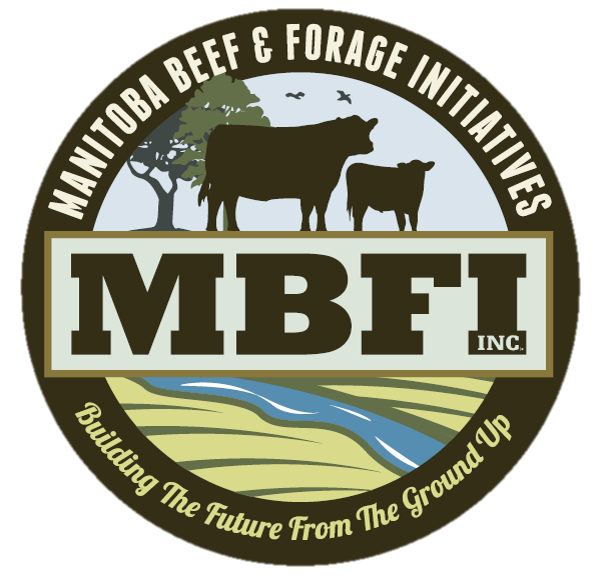High-sugar forages give beef a boost
STUDIES SHOW ENERGY DENSE FEED IS EASIER FOR CATTLE TO DIGEST AND IMPROVES RUMEN HEALTH AND WEIGHT GAIN
By Robert Arnason of the Western Producer
BROOKDALE, Man. — On a hot, bordering on stifling July day in western Manitoba, the Boston plantain in Juanita Kopp’s hand was obviously suffering.
The plant was wilted, droopy and resembled an unappetizing leaf of lettuce.
The plantain wasn’t doing particularly well because it had been removed from the soil. Its cousins in the ground were doing much better at the Manitoba Beef and Forage Initiative (MBFI) research farm east of Brookdale, Man.
Kopp, a livestock production specialist with Manitoba Agriculture, showed off the plantain during a presentation at the MBFI field tour July 26.
She and other Manitoba Agriculture experts are studying Boston plantain and other high-sugar forage crops at four sites across the province.
“I know it (plantain) is used more in the U.K., New Zealand and Australia,” Kopp said.
“It’s more novel for Manitoba.”
Scientists want to know if plantain, along with antler chicory, Nabucco Italian ryegrass and perseus festulolium, can be successfully grown in Manitoba and if the high-sugar forages will benefit beef cattle production.
The inspiration for the project came from Clayton Robins, a former beef research assistant with Agriculture Canada in Brandon and a producer near Rivers, Man.
Robins earned a Nuffield Scholarship in 2013, and he chose to study energy dense forages and their potential application in Canada.
After travelling to Wales, Scandinavia, Spain and the United States, Robins learned that beef producers in many countries value forage with a high sugar content.
Most Canadian legumes and grasses have a sugar content of seven to 12 percent, but chicory, plantain and other high-sugar forage crops can have a sugar content of 20 to 30 percent.
Research suggests that livestock can metabolize feed more efficiently when the sugar content is higher.
“Cattle that consume forages with higher-sugar content have higher rates of gain, improved performance and better rumen health,” the Beef Cattle Research Council says on its website.
Robins spoke at numerous events on the Prairies in 2014 and 2015 to spread the word about high-sugar forages. His message may be gaining traction because a few Manitoba producers are experimenting with high-sugar forage crops or are curious about the concept, Kopp said.
“We went to a couple of presentations that Clayton gave and there was a lot of interest.”
Manitoba Agriculture decided to research the possibilities.
The scientists want to know if these forages can be used for late season grazing to provide a nutrient rich source of feed before winter.
“It’s going to fit in that fall grazing period. You’re not going to be baling it up,” Kopp said.
“It’s typically seeded late May or early June.”
Kopp and her colleagues seeded the four forage species in plots at four sites last year in late May and early June.
Early results suggest the forages can thrive in the eastern Prairies because they produced a substantial amount of dry matter.
- chicory: 3.7 tons per acre
- plantain and Italian ryegrass: 4.1 tons per acre
- Festulolium: 4.8 tons per acre
The Alberta Agriculture website says alfalfa can generate two to seven tons per acre, so the high- sugar forage species have comparable production.
“The potential for productivity is definitely there, but keep in mind it is plot (research),” Kopp said.
Scientists also measured the total digestible nutrients (TDN) of the four forage species:
- chicory: 67 percent
- plantain: 62
- Italian ryegrass: 64
- Festulolium: 62
“A lactating cow would need 65 percent TDN in her diet, so pretty much (the forages) meet that requirement,” Kopp said.
Manitoba Agriculture researchers are repeating the experiment this year, but at Brookdale it’s being done on a bigger scale. They seeded chicory and plantain on a larger piece of land, and cattle will graze the site this fall.
“(We will) have our cow-calf pairs go in and weigh them before they go in,” Kopp said.
“Then get two or three weeks (of grazing) … and get a sense of average daily gain…. It’s not foundational research by any means. It’s more demonstrative.”
Manitoba Agriculture scientists aren’t the only ones studying the potential of high-sugar forages in Canada.
Gilles Belanger, an Agriculture Canada researcher in Quebec, is looking at ways to increase the sugar content of alfalfa, including harvesting in the late afternoon and breeding alfalfa with higher sugar concentration.
